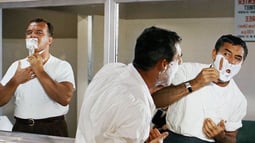

How to stop a shaving cut from bleeding
Photos Universal Pictures
Words Matthieu Morge-Zucconi
Share the article on
No, it doesn’t involve toilet paper.
You never quite know how your Monday morning will go, right? Back to the office after a busy weekend, hopefully full of good intentions. You decide to start your week with a really close shave, only to end up nicking yourself. But how do you stem the bleeding quickly enough to avoid being late for your first meeting, starting your day - and your week - off on the wrong foot?
First a quick lesson to help you avoid cutting yourself shaving in the first place. It can happen for lots of reasons, starting with the most obvious: rushing and carelessness. Sometimes you're in a hurry – that's just the way it is. Then there are ingrown hairs and other skin imperfections that can lead to a cut, much like a badly-placed speed bump on your morning commute.
Thankfully, there's a remedy that has been passed down through the generations since time immemorial which involves dabbing the cut with a styptic pencil or an alum block. While the Bear Grylls approach of 'improvise, adapt, overcome' might include using toilet paper, we don't recommend it. Toilet paper is designed to dissolve easily, which doesn't bode well with a fresh wound. Moreover, relying on this method only stops the bleeding without actually treating the cut itself.
The proper solution is right here – six easy, effective steps to help you regain control of your day.
Step one
Hold a towel soaked in warm water against the cut for around 30 seconds. The warmth of the water helps clean the cut and stem the bleeding.
Step two
Apply a bit of toner, aftershave, or any other alcohol-based product to the cut. This will disinfect the wound. In extreme situations, if you have absolutely nothing else, even whisky can do the trick.
Step three
Then place an ice cube on the cut for 15 seconds. This stimulates your blood vessels and quickly stops the blood flow.
Step four
Find your lip balm. If it's new, apply a small amount directly to the cut. If not, cut off the part that's been in contact with your mouth to prevent any germs from infecting the wound. The nourishing properties of lip balm will keep the blood within the skin while keeping bacteria out.
Step five
If needed, after about 30 seconds from the previous step, use the towel from step one to wipe off any excess lip balm.
Step six
Apply a bit of moisturiser or aftershave gel. This will protect and soothe your skin, getting it ready for the busy day ahead.
Advanced knowledge: Understand your hair growth direction
Additionally, understanding the direction of hair growth is a crucial aspect of achieving a smoother and more comfortable shaving experience. To determine the grain of your hair, gently run your hand across the skin in different areas of your face. You'll notice that the hair feels slightly rougher in one direction and smoother in another. Shaving in the direction of hair growth (with the grain) helps reduce the risk of irritation, nicks, and ingrown hairs. Take a moment to familiarize yourself with these patterns; it's a small but significant step towards mastering the art of shaving.
Is shaving against the Grain Safe ?
Shaving against the grain can provide an ultra-close shave, but it comes with downsides. It increases the risk of irritation, ingrown hairs, and razor bumps due to the strong blade contact. While some areas of your face may tolerate it, proceed with caution. Prep your skin, use a good razor, and always use shaving cream or gel to reduce friction. Each person's skin reacts differently, so gentle experimentation is key. If you choose to shave against the grain, pay attention to your skin's response to prevent discomfort or issues. Balancing closeness with skin health tailors your approach to your needs.
What's the healing time for shaving cuts?
The duration for shaving cuts to heal can vary. Generally, minor cuts tend to heal within a few days to a week. The healing process depends on factors like the depth of the cut, your skin's natural healing pace, and the quality of your aftercare. To speed up the healing process, keep the cut clean, apply a styptic pencil or a cold compress to stop bleeding, and use an antibiotic cream to prevent infection. Should a cut appear infected or not heal within a reasonable timeframe, seeking medical advice is recommended.
Will Vaseline stop a shaving cut from bleeding?
The answer is a resounding YES! Vaseline, that trusty and versatile petroleum jelly, can indeed come to your rescue when you're in the middle of a shaving mishap. But how? Let's delve into the science a little. Vaseline is what’s known as an ‘occlusive moisturizer’. This means it works by forming a protective barrier on the skin, trapping in moisture to aid healing. Now, when you get a shaving cut, what you really need is for that cut to clot and heal fast. Vaseline, with its soothing and protective properties, creates an environment conducive to this healing process, by keeping the area moist and protecting the wound from further damage or infection. Not only does Vaseline help stop the bleeding, it also minimizes the chances of scarring! Its ability to keep the wound moist reduces the formation of hard scab tissue, which is responsible for leaving those pesky scars. So, not only does it stop the blood flow, but it also ensures that your skin will remain as smooth and unblemished as possible!

